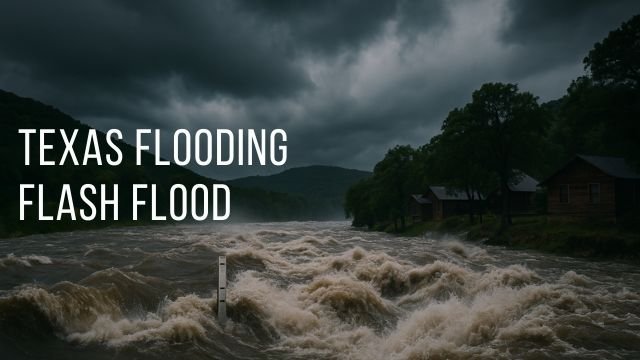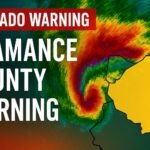When the skies opened above Central Texas this July, they didn’t just rain, they roared. What started as a forecast of “localized heavy rain” quickly turned into one of the deadliest events in Texas Hill Country history. Overnight on July 3rd into the 4th, a ferocious storm system dumped more than 12 inches of rain on the already soaked limestone hills of Kerr and Gillespie counties. The result was catastrophic. A fast-rising Guadalupe River, broken gauges, unheeded warnings, and the heartbreaking loss of lives at summer camps caught directly in the path.
The Texas flooding flash flood didn’t come with much warning. In fact, that’s part of the problem. Flash floods are sneaky. They’re not like hurricanes that lumber their way toward the coast over days. These floods explode onto the scene, fed by terrain, trapped moisture, and the limits of our communication systems.
So let’s walk through what actually happened over the 4th of July weekend. We’ll talk about the meteorology, the lives changed, and the infrastructure pushed to its limits. This post is built to explain things clearly, human to human, while keeping our radar on what matters most — how to stay safer next time.
A river that rose faster than text alerts
Between midnight and 6 a.m. on July 4, a slow-moving system soaked the Hill Country with totals usually seen over several months. One gauge in Kerr County reported 12 inches. The most shocking stat? The Guadalupe River at Hunt surged from under 7 feet to over 29 feet in less than two hours. Imagine that. In the time it takes to watch a movie, a calm river turns into a destructive wall of water.
The National Weather Service did issue a Flash Flood Watch, then a Warning, and finally — just before sunrise — a Flash Flood Emergency. But for many, it was too late.
Dozens of low-water crossings flooded. Cabins along the river vanished into the current. Bridges were washed away. Power poles snapped. Roads buckled. Emergency crews were stretched so thin that local residents in Jonestown, Ingram, and Mountain Home took to social media begging for boat rescues.
Camp Mystic and the human cost
One of the most heartbreaking stories came from Camp Mystic, a well-known girls’ camp near Hunt that’s been around since 1926. With no real warning sirens, and no night staff trained for disaster response, the rising water trapped hundreds of young campers and staff.
Eleven people were swept into the river. Only ten made it back.
Twenty-three-year-old counselor Chloe Childress died trying to help girls get to safety. Her body was found 25 miles downstream near Center Point. She was described as gentle, brave, and someone who sang to the girls each night at campfire.
The loss shook the entire state. Parents, friends, and alumni poured in tributes. Politicians, from the governor to the President, acknowledged her sacrifice.
Yet questions also poured in. Why weren’t the river gauges working? Why hadn’t a 2022 federal grant been used to upgrade the camp’s warning system? Why didn’t the camp evacuate when the first Watch was issued?
Texas flooding flash flood exposed old problems
The Hill Country has always been one of the most flash-flood prone areas in the United States. The hills funnel rainwater into narrow riverbeds. The limestone doesn’t absorb water. The rivers are fast, even in dry times.
But many counties still rely on outdated warning systems. Some don’t have working river gauges. Others have no push-notification alerts for residents. And even when alerts go out, there’s confusion about what they mean.
A “Watch” feels distant. A “Warning” might feel urgent, but if you’re asleep, you’ll never know.
That night, Camp Mystic didn’t have a clear evacuation protocol. They didn’t call buses. They didn’t move girls to higher ground. Parents say they never got emergency texts. It was a perfect storm of natural danger and human delay.
What happens now?
As of July 7, the confirmed death toll has climbed above 80, with dozens still hospitalized. Texas National Guard teams continue to help clean up debris. FEMA has deployed mobile assistance units. Governor Abbott has declared a disaster in 29 counties, unlocking recovery funds.
But money can’t rebuild everything. Parents have lost children. Campers are traumatized. Farmers have lost their orchards. The community of Hunt, once known for its peaceful riverbend retreats, now carries deep scars.
Here’s what experts and residents alike are demanding:
- Install real-time telemetry on all Hill Country river gauges.
- Bring back river sirens, even if they’re old-school.
- Require all camps to have emergency flood protocols and annual drills.
- Expand flood education in schools and youth camps, especially for counselors under 25.
A future full of storms
The Texas flooding flash flood wasn’t just a freak event. It was part of a larger pattern. Climate experts note that the Gulf of Mexico is warmer than average this year, feeding more moisture into the air. That means storms pack more punch.
When you add that to poor drainage and aging infrastructure, the Hill Country becomes a flash-flood pressure cooker. The rain might be local, but the impact reaches national headlines.
This July disaster taught us, once again, that warnings don’t mean much unless people hear them, understand them, and act fast. You don’t get a second chance when a river rises 20 feet in 90 minutes.
In a state known for big skies and bigger resilience, Texans are once again rebuilding. But this time, they’re also asking for more — more preparation, more reliable systems, and more respect for the power of moving water.


